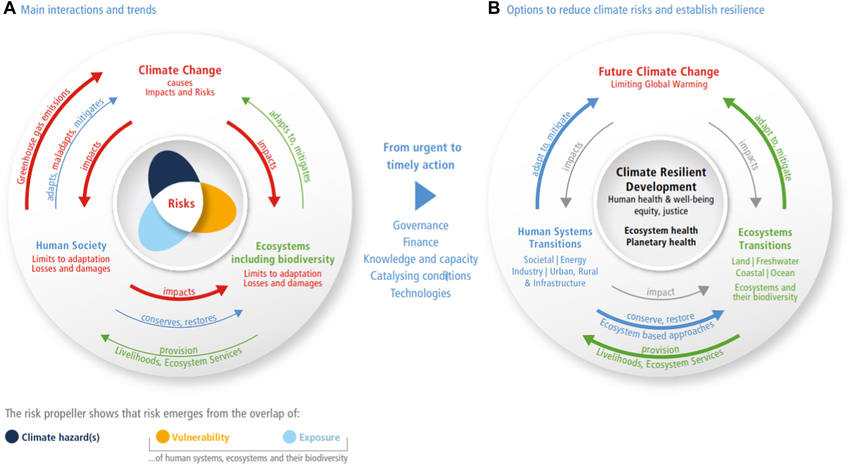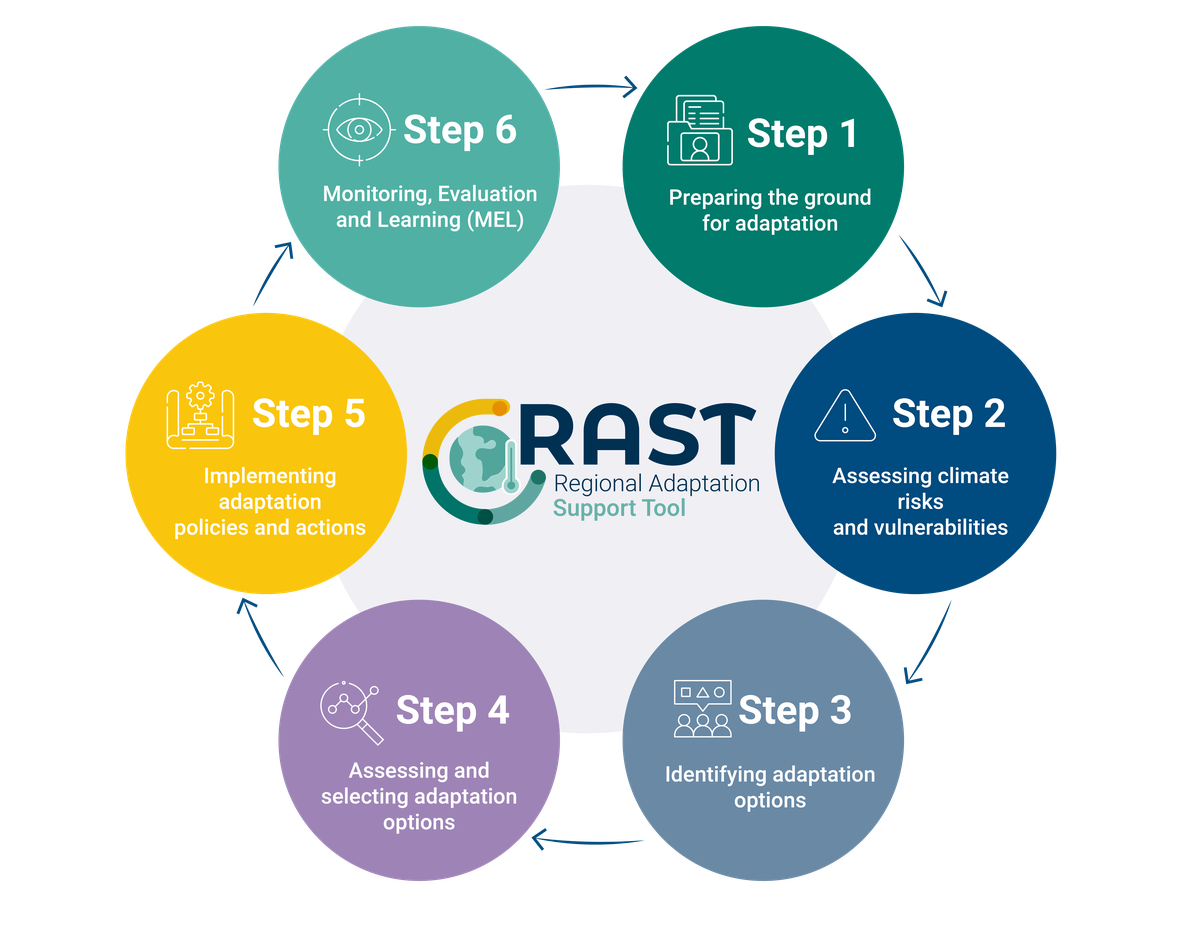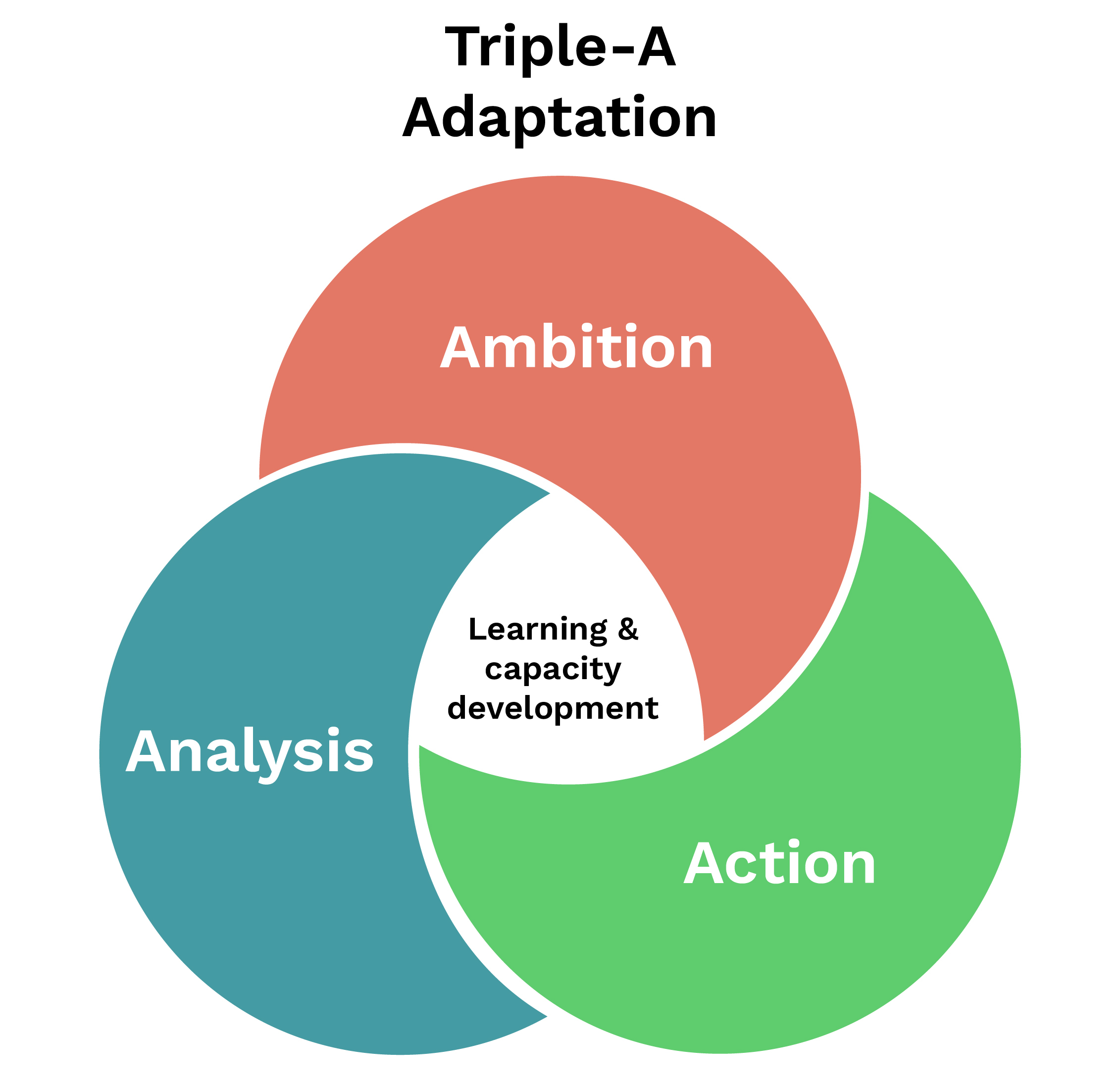Climate adaptation for sustainable development
Climate adaptation is fundamental for achieving climate resilience, enabling countries, regions, cities and communities to prepare for and respond to the impacts of climate change. Climate adaptation planning refers to the development and implementation of policies, strategies and actions aimed at reducing climate-related risks and vulnerabilities affecting both environmental and socio-economic systems. Key international frameworks, such as the Paris Agreement (Article 7) and the UNFCCC National Adaptation Plan (NAPs), guide governments and organizations in designing and implementing adaptation measures that strengthen long-term sustainability. These frameworks emphasize integrated risk management, resilience building and the alignment of adaptation policies with national and sectorial planning processes. Beyond risk reduction, climate adaptation planning is also important to support the design of climate-resilient development pathways, which are indicated as “the process of implementing greenhouse gas mitigation and adaptation measures to support sustainable development for all” (IPCC 2022). To be effective, adaptation planning must adopt a multi-risk approach, considering not only climate-related hazards but also socio-economic and institutional vulnerabilities.

Figure 1: From climate risk to climate resilient development. Source:
https://www.ipcc.ch/report/ar6/wg2/downloads/report/IPCC_AR6_WGII_SummaryForPolicymakers.pdf?itid=lk_inline_enhanced-template
Adaptation principles
Climate-ADAPT provides a list of adaptation principles emerged over the years that can support local and regional authorities in stepping up climate adaptation efforts.
Sustainable
Adaptation should be socially, financially and environmentally sustainable.
Evidence-based
Adaptation planning and actions should be informed by the latest scientific knowledge and data, including future risks.
Place-based
There is no one-size-fits-all approach to adaptation.
Inclusive and socially just
Adaptation is more effective when it involves diverse actors (e.g. public administrations, civil society and different sectors) coordinating across governance levels.
Monitored, evaluated and continuously improved
Using clear indicators is vital to monitor and assess your adaptation progress continuously.
Flexible and iterative
Adaptation planning should be flexible due to uncertainties surrounding future climate and socio-economic conditions.
In addition, an effective adaptation planning process should aim at incorporating cost-effectiveness and efficiency, ensuring that the available resources (financial and human) are allocated optimally. Policy integration is also critical, aligning adaptation measures with existing national and sectoral policies, such as disaster risk reduction strategies and urban planning frameworks. Furthermore, transparency and accountability should be upheld throughout the process to foster trust, stakeholder engagement, and inclusive governance.
The Regional Adaptation Support Tool
The adaptation planning process can be facilitated by decision-support tools which help policymakers, planners and stakeholders in taking informed, data-driven decisions in response to climate risk. These tools usually provide structured methodologies, framework or platforms to facilitate the assessment of climate vulnerabilities, the selection of the preferred adaptation measures and their integration into the planning process.
The Regional Adaptation Support Tool (RAST) is designed to help local and regional authorities with climate change adaptation strategies and plans, from the development phase to implementation, and monitoring and evaluating. It provides a step-by-step, flexible and iterative framework for identifying, assessing, and implementing adaptation measures at the regional or city level. The RAST provides practical guidance in 6 steps aligned with the key features of climate adaptation policy processes:

Figure 2: The Regional Adaptation Support Tool. Source:
https://climate-adapt.eea.europa.eu/en/mission/knowledge-and-data/regional-adaptation-support-tool
1. Preparing the ground for adaptation: assemble and organize the essential components to start the adaptation process. It includes gather data and evidence base, secure long-term political commitment for adaption, establish adaptation governance (including the identification of statehooders and engagement plan), assess resources needed and develop a clear communication strategy for all.
2. Assessing climate risk and vulnerabilities: evaluate the climate risks and vulnerability of the considered area. This is done by defining the climate risk assessment principles, methodology and governance; analyse data on climaterelated hazards, exposure and vulnerability; highlight key risks (who and what is at most risk?) By prioritizing most urgent risks, it is possible to determine adaptation priorities and set adaptation objectives.
3. Identify adaptation options: Identifying a range of adaptation measures. This phase includes the creation of a catalogue of adaptation options that are aligned with the identified adaptation priorities and objectives. In this phase, it is also useful to look at good examples of adaptation measures and collect lessons learned.
4. Assessing and selecting adaptation options: Once a set of adaptation options has been identified, a framework with selection criteria should be established to assess the different alternatives and choose which options should be implemented first. The criteria can include aspects such as contribution to sustainability objectives, costs, feasibility, impact on local or regional development, etc.
5. Implement adaptation policies and action: The selected implementation actions can be implemented, either through standalone initiatives or by integrating these into broader plans and strategies. Mainstreaming adaptation into sector policies can enhance this process and increase effectiveness. At the same time, securing funding or financing resources is critical for the successful implementation and this should be done as soon as possible.
6. Monitoring, evaluation and learning (MEL): regularly monitoring and evaluating the effectiveness of adaptation actions (as well as making adjustments where needed) is a critical step to ensure that the adaptation plans are on track and deliver the expected results.
REACHOUT Triple-A approach to adaptation planning
Cities and local authorities have access to an increasing number of tools, services and frameworks to support them in planning for adaptation and building climate resilience. However, identifying and selecting the right tool for specific needs can be challenging, given the wide range of options. REACHOUT Triple-A approach provides a flexible and modular “Triple-A Approach” to organize climate adaptation and resilience activities with a focus on simplicity. The three steps are: Analysis, Ambition, Action. These steps do not have a predefined order and can be adapted to the local context and needs to address specific goals or challenges.

Analysis
Ambition
Action
Summary
Reflection
- What are key features of an effective climate adaptation planning process?
2. What are the six steps of the Regional Adaptation Support Tool?




